轴承盖落料、拉深、冲孔复合模设计(有cad图)
- 格式:doc
- 大小:1.32 MB
- 文档页数:34
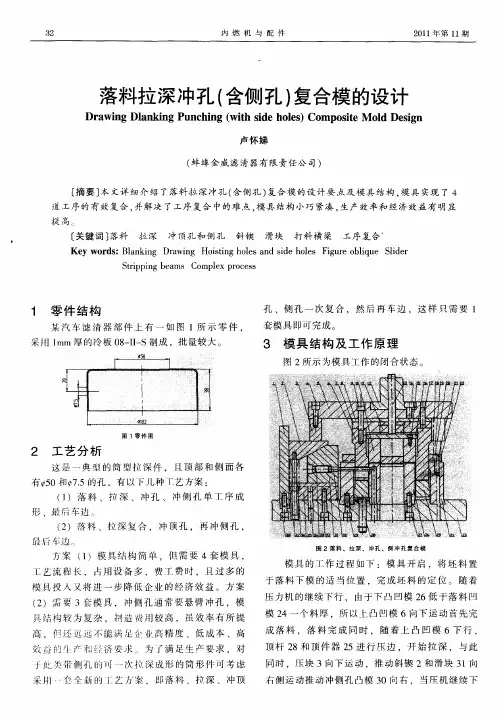
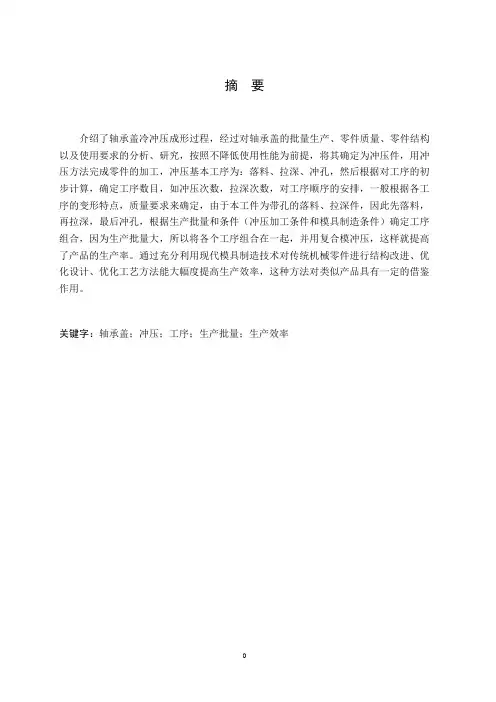
摘要介绍了轴承盖冷冲压成形过程,经过对轴承盖的批量生产、零件质量、零件结构以及使用要求的分析、研究,按照不降低使用性能为前提,将其确定为冲压件,用冲压方法完成零件的加工,冲压基本工序为:落料、拉深、冲孔,然后根据对工序的初步计算,确定工序数目,如冲压次数,拉深次数,对工序顺序的安排,一般根据各工序的变形特点,质量要求来确定,由于本工件为带孔的落料、拉深件,因此先落料,再拉深,最后冲孔,根据生产批量和条件(冲压加工条件和模具制造条件)确定工序组合,因为生产批量大,所以将各个工序组合在一起,并用复合模冲压,这样就提高了产品的生产率。
通过充分利用现代模具制造技术对传统机械零件进行结构改进、优化设计、优化工艺方法能大幅度提高生产效率,这种方法对类似产品具有一定的借鉴作用。
关键字:轴承盖;冲压;工序;生产批量;生产效率ABSTRACTIntroduced to carry the bearing cover cold hurtle to press to take shape the process, pass by to the batch quantity production, spare parts quantity, the spare parts structure and usage request of carry the bearing cover of analysis, study, according to not lower to use the function as premise, is certain in order to hurtle to press the piece, it uses to hurtle to press the method to complete the spare parts to process, hurtling to press basic work preface is: Fall to anticipate, pull deep, hurtle the bore, then according to the initial calculation of the work preface, make sure the work ordinal number eyes, if hurtle to press the number of times, pulling the deep number of times, to the in proper order arrangement of the work preface, general transform the characteristics according to each work preface, the quantity request to certain, because of in order to take the bore to fall to anticipate, pull the deep piece, this work piece so fall to anticipate first, then pull deeply, blunt bore of end, according to produce the batch quantity and condition( hurtle to press to process the condition and molding tools to make the condition)s to make sure the work that the preface combine, because of produce the batch quantity big, so combine each work preface together, counteract compound the mold hurtles to press, raising the rate of production of the product thus. Pass to make use of the modern molding tool manufacturing technique to carry on the structure improvement to the traditional machine spare parts well, excellent turn the design, the excellent chemical engineering skill method ability the significant exaltation produces the efficiency, this kind of method to similar the product has to certainly draw lessons from the function.Key words: bearing cover; stamping; process; Production batch; Production efficiency目录1 分析零件的工艺性 (5)1.1 冲裁工艺性 (5)1.2 拉深工艺性 (5)2 分析计算确定工艺方案 (7)2.1 计算毛坯尺寸 (7)2.2 确定是否需要压边圈 (7)2.3 计算拉深次数 (8)2.4 确定工艺方案 (9)3 主要工艺参数的计算 (10)3.1 确定排样、裁板方案 (10)3.2 计算工艺力、初选压力机 (11)3.2.1 计算工艺力 (11)3.2.2 初选压力机 (14)3.3 计算压力中心 (14)3.4 计算凸、凹模刃口尺寸及公差 (15)4 模具的整体结构设计 (17)4.1 模具结构形式的选择 (17)4.2 模具总体设计 (17)4.3 模具工作部分尺寸计算 (18)4.3.1 落料凹模 (18)4.3.2 冲孔凸模 (19)4.3.3 拉深凸模 (19)4.3.4 凸凹模 (19)5 模具的主要零部件结构设计 (21)5.1 模架 (21)5.2 模座 (21)5.3 模柄 (21)5.4 定位零件 (22)5.4.1 挡料销 (22)5.4.2 导料销 (22)5.4.3 导料板 (22)5.5 卸料装置 (23)5.5.1 固定卸料板 (23)5.5.2 橡胶 (24)5.6 其他支撑与固定零件 (24)5.6.1 凸模固定板 (24)5.6.2 导向零件 (25)5.6.3 垫板 (25)5.7 紧固件 (25)6 确定冲压设备 (27)7 模具的装配 (28)7.1 复合模的装配 (28)7.2 凸、凹模间隙的调整 (28)8 重要零件的加工工艺过程编制 (29)结论 (31)致谢 (32)参考文献 (33)1 分析零件的工艺性1.1 冲裁工艺性冲裁件的工艺性是指冲裁件对冲压工艺的适应性,即冲裁件的结构形状、尺寸大小、精度等级是否符合冲裁加工的工艺要求。
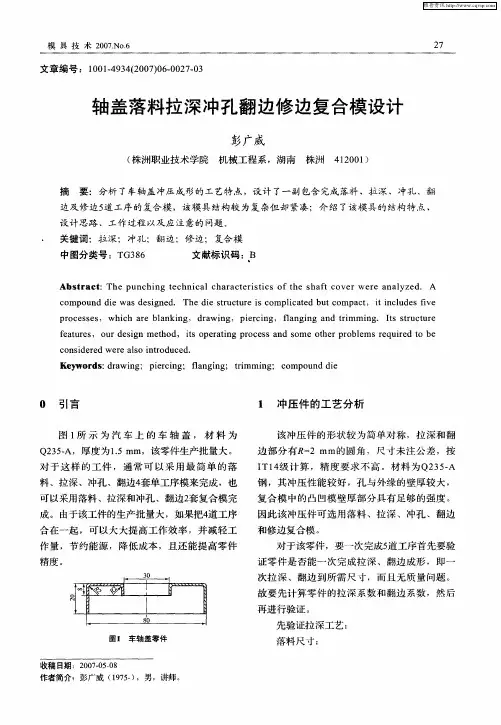
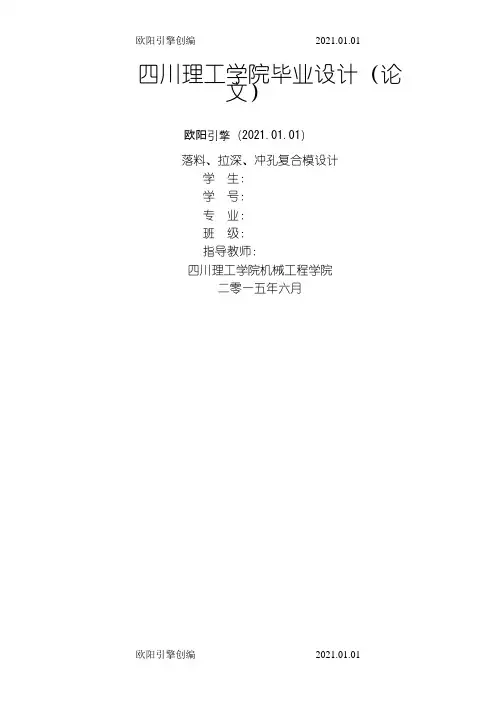
四川理工学院毕业设计(论文)欧阳引擎(2021.01.01)落料、拉深、冲孔复合模设计学生:学号:专业:班级:指导教师:四川理工学院机械工程学院二零一五年六月四川理工学院毕业设计(论文)任务书设计(论文)题目:落料、拉深、冲孔复合模设计学院:机械学院专业:材控班级:2011级1班学号:11011023174学生:指导教师:接受任务时间 2015.3.9教研室主任(签名)院长(签名)一.毕业设计(论文)的主要内容及基本要求内容:落料、拉深、冲孔复合模设计;产品工件图见附图;生产批量:大批量要求:要求有摘要(中、英文)、目录、设计任务书、产品图及设计说明书。
1.工件工艺性分析(1)根据工件图,分析其形状、尺寸、精度、断面质量、装配关系等要求。
(2)根据生产批量,决定模具的结构形式、选用材料。
(3)分析工件所用材料是否符合冲压工艺要求。
2.确定合理的工艺方案:应有两个以上的工艺方案比较分析。
(1)根据工艺分析,确定基本的工序性质。
如:落料—拉深(2)根据工艺计算,确定工序数目。
(3)根据生产批量和条件(材料、设备、工件精度)确定工序组合。
如:复合冲压工序或连续冲压工序3.工艺计算(1)计算毛坯尺寸,合理排样,绘排样图,计算材料利用率。
(2)计算冲压力,如:冲裁力、弯曲力、拉伸力、卸料力、推件力、压边力等以便确定压力机。
(3)计算压力中心,防止模具受偏心负荷,受损。
(4)计算并确定模具主要零件(凸模、凹模、凸模固定板、垫板等)外形尺寸及弹性元件的自由高度。
(5)确定凸、凹模间隙,计算凸、凹模工作部分尺寸。
4.模具总体结构设计(1)进行模具结构设计,确定结构件形式和标准。
(2)绘制模具总体结构草图,初步计算并确定模具闭合高度,概算模具外形尺寸。
5.选择冲压设备根据工厂现有设备及要完成的冲压工序性质、冲压加工所需的变形力、变形功和模具的闭合高度、轮廓尺寸等因素,选用压力机的型号、规格。
6.模具图样设计(1)绘制模具总图.主视图:常取模具的工作位置(闭模状态),采用剖面画法。
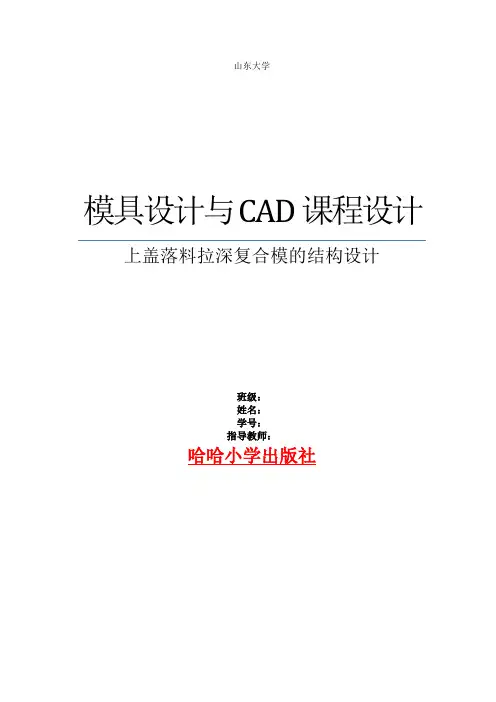
山东大学模具设计与CAD课程设计上盖落料拉深复合模的结构设计班级:姓名:学号:指导教师:哈哈小学出版社目录零件图一、零件冲压加工工艺性分析--------------------------------------31、毛坯尺寸计算-------------------------------------------------------------------------32、判断是否可一次拉深成形-------------------------------------------------------- 33、确定是否使用压边圈--------------------------------------------------------------- 44、凹凸模圆角半径的计算------------------------------------------------------------45、确定工序内容及工序顺序---------------------------------------------------------4二、确定排样图和裁板方案------------------------------------------41、板料选择--------------------------------------------------------------------------------42、排样设计--------------------------------------------------------------------------------4三、主要工艺参数的计算1、工艺力计算----------------------------------------------------------------------------62、压力机的选择-------------------------------------------------------------------------6四、模具设计1、模具结构形状设计------------------------------------------------------------------72、模具工作尺寸与公差计算--------------------------------------------------------7五、工作零件结构尺寸和公差的确定1、落料凹模板----------------------------------------------------------------------------82、拉深凸模--------------------------------------------------------------------------------93、凹凸模-----------------------------------------------------------------------------------9六、其他零件结构尺寸1、模架的选择----------------------------------------------------------------------------92、凹凸模固定板的选择--------------------------------------------------------------103、磨柄的选择---------------------------------------------------------------------------104、卸料装置-------------------------------------------------------------------------------105、推荐装置的选择------------------------------------------------------------------116、销、钉的选择---------------------------------------------------------------------117、模具闭合高度的校核------------------------------------------------------------11七、参考目录------------------------------------11零件图:材料:A3钢厚度:t=1mm一、零件冲压加工工艺性分析材料:该冲裁件的材料A3钢是低碳钢,拉深工艺性较好。
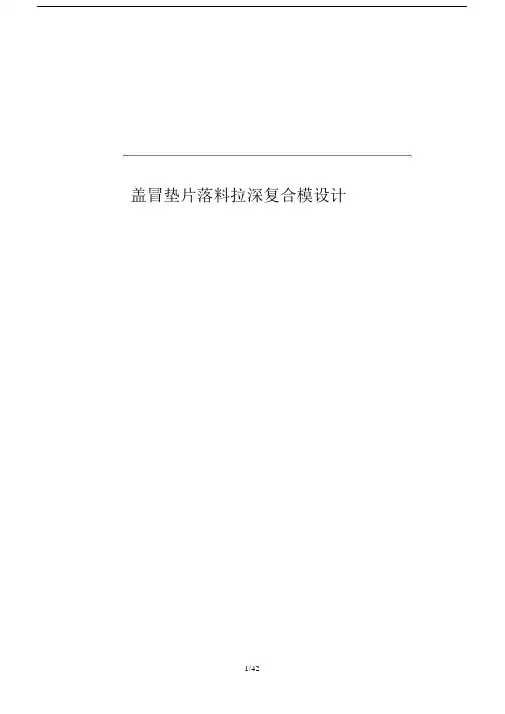
盖冒垫片落料拉深复合模设计摘要本次设计了一套冲孔,落料的模具。
经过查阅资料,首先要对零件进行工艺分析,经过工艺分析和对比,采用冲孔落料工序,通过冲裁力,顶件力,卸料力等的计算,确定压力机的型号。
在分析对冲压件加工的模具适用类型选择所需的模具。
得出将设计的模具类型后将模具的各个工作零件部件的设计过程表达出来。
在文档中第一部分,主要叙述了冲压模具的发展状况,说明了冲压模具的重要性与本次设计的意义,接着是对冲压件的工业分析,完成了材料利用率的计算。
在进行冲裁工艺力的计算和冲裁模工作部分的设计计算,对选择冲压设备提供依据。
最后是对主要零部件的选择。
本次设计阐述了冲压落料复合模的结构设计及工作过程。
本模具性能可靠,运行平稳,提高了产品质量和生产效率,降低劳动强度和生产成本。
关键字:冲压:落料冲孔:复合模:模具结构ABSTRACTThe design of a punching, blanking die. Through access to information, we must first process the parts analysis, technology analysis andcomparison by using the punch blanking process, through the blanking force, the top pieces of force, discharge force of the calculations to determine the type presses. In the analysis of the stamping process to select the desired type of mold for the mold. Types obtained after the design ofthe mold die parts of the various working parts of the design process of expression.In the first part of the document, the main account of the developmentof stamping die, stamping die shows the importance and significance ofthis design, then is the stamping industry analysis, completed thematerial utilization rate calculation. Calculation of force during the blanking process and the work of some of blanking die design calculation, provide the basis for the selection of stamping equipment. Finally, the choice of the main components.The design described blanking compound die stamping design andworking process.Reliable performance of the mold, smooth operation,improved product quality and production efficiency, reduce labor intensityand production costs.Keywords: Stamping: Blanking punch: Compound Die: die structure目录1 前言 (1)1.1 冲压的概念、特点及应用 (1)1.2 冲压的基本工序及模具 (2)1.3 冲压技术的现状及发展方向 (3)2 零件工艺性分析 (7)3. 拉深工艺及拉深模有设计 (8)设计要点 (8)3.1 有凸缘圆筒形件的拉深方法及工艺计算 (8)3.2 宽凸缘圆筒形件的工艺计算要点 (9)3.3 、拉深凸模和凹模的间隙 (10)3.4 拉深凸模,凹模的尺寸及公差 (10)3.5 凹模圆角半径 RD (11)3.6 凸模圆角半径 R P. (12)4、冲裁工艺及冲裁模具的设计 (13)4.1 、凸模与凹模刃口尺寸的计算 (13)4.2 、凸、凹模刃口尺寸的计算方法 (13)4.3 落料和冲孔。
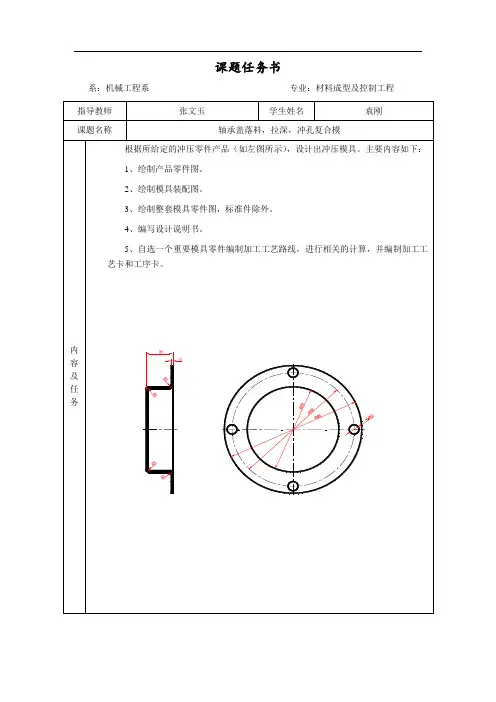
课题任务书系:机械工程系专业:材料成型及控制工程开题报告摘要介绍了轴承盖冷冲压成形过程,经过对轴承盖的批量生产、零件质量、零件结构以及使用要求的分析、研究,按照不降低使用性能为前提,将其确定为冲压件,用冲压方法完成零件的加工,冲压基本工序为:落料、拉深、冲孔,然后根据对工序的初步计算,确定工序数目,如冲压次数,拉深次数,对工序顺序的安排,一般根据各工序的变形特点,质量要求来确定,由于本工件为带孔的落料、拉深件,因此先落料,再拉深,最后冲孔,根据生产批量和条件(冲压加工条件和模具制造条件)确定工序组合,因为生产批量大,所以将各个工序组合在一起,并用复合模冲压,这样就提高了产品的生产率。
通过充分利用现代模具制造技术对传统机械零件进行结构改进、优化设计、优化工艺方法能大幅度提高生产效率,这种方法对类似产品具有一定的借鉴作用。
关键字:轴承盖;冲压;工序;生产批量;生产效率ABSTRACTIntroduced to carry the bearing cover cold hurtle to press to take shape the process, pass by to the batch quantity production, spare parts quantity, the spare parts structure and usage request of carry the bearing cover of analysis, study, according to not lower to use the function as premise, is certain in order to hurtle to press the piece, it uses to hurtle to press the method to complete the spare parts to process, hurtling to press basic work preface is: Fall to anticipate, pull deep, hurtle the bore, then according to the initial calculation of the work preface, make sure the work ordinal number eyes, if hurtle to press the number of times, pulling the deep number of times, to the in proper order arrangement of the work preface, general transform the characteristics according to each work preface, the quantity request to certain, because of in order to take the bore to fall to anticipate, pull the deep piece, this work piece so fall to anticipate first, then pull deeply, blunt bore of end, according to produce the batch quantity and condition( hurtle to press to process the condition and molding tools to make the condition)s to make sure the work that the preface combine, because of produce the batch quantity big, so combine each work preface together, counteract compound the mold hurtles to press, raising the rate of production of the product thus. Pass to make use of the modern molding tool manufacturing technique to carry on the structure improvement to the traditional machine spare parts well, excellent turn the design, the excellent chemical engineering skill method ability the significant exaltation produces the efficiency, this kind of method to similar the product has to certainly draw lessons from the function.Key words: bearing cover; stamping; process; Production batch; Production efficiency目录摘要abstract1 分析零件的工艺性 (1)1.1 冲裁工艺性 (1)1.2 拉深工艺性 (1)2 分析计算确定工艺方案 (3)2.1 计算毛坯尺寸 (3)2.2 确定是否需要压边圈 (3)2.3 计算拉深次数 (4)2.4 确定工艺方案 (5)3 主要工艺参数的计算 (7)3.1 确定排样、裁板方案 (7)3.2 计算工艺力、初选压力机 (9)3.2.1 计算工艺力 (9)3.2.2 初选压力机 (12)3.3 计算压力中心 (12)3.4 计算凸、凹模刃口尺寸及公差 (13)4 模具的整体结构设计 (15)4.1 模具结构形式的选择 (15)4.2 模具总体设计 (15)4.3 模具工作部分尺寸计算 (16)4.3.1 落料凹模 (16)4.3.2 冲孔凸模 (17)4.3.3 拉深凸模 (17)4.3.4 凸凹模 (17)5 模具的主要零部件结构设计 (19)5.1 模架 (19)5.2 模座 (19)5.3 模柄 (19)5.4 定位零件 (20)5.4.1 挡料销 (20)5.4.2 导料销 (20)5.4.3 导料板 (20)5.5 卸料装置 (21)5.5.1 固定卸料板 (21)5.5.2 橡胶 (22)5.6 其他支撑与固定零件 (22)5.6.1 凸模固定板 (22)5.6.2 导向零件 (23)5.6.3 垫板 (23)5.7 紧固件 (23)6 确定冲压设备 (25)7 模具的装配 (26)7.1 复合模的装配 (26)7.2 凸、凹模间隙的调整 (26)8 重要零件的加工工艺过程编制 (27)结论 (29)致谢 (30)参考文献 (31)1 分析零件的工艺性1.1 冲裁工艺性冲裁件的工艺性是指冲裁件对冲压工艺的适应性,即冲裁件的结构形状、尺寸大小、精度等级是否符合冲裁加工的工艺要求。
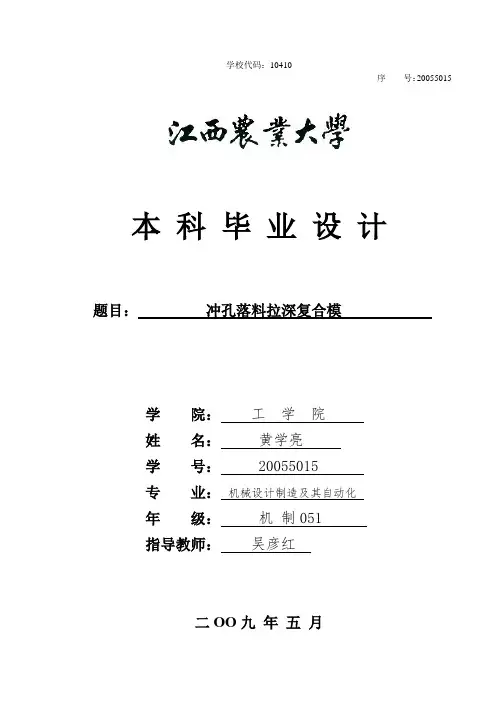
学校代码:10410序号:20055015本科毕业设计题目:冲孔落料拉深复合模学院:工学院姓名:黄学亮学号:20055015专业:机械设计制造及其自动化年级:机制051指导教师:吴彦红二OO九年五月冲孔落料拉深复合模目录前言.1.设计课题 (1)1.1设计任务书 (2)2.工艺方案分析及确定 (3)2.1件的工艺分析 (3)2.2工艺方案的确定 (4)2.3冲压件坯料尺寸的确定 (4)2.4拉深次数的确定 (4)2.5排样的确定 (5)3.工艺设计与计算 (7)3.1冲裁的方式与冲压力的计算 (7)3.1.1、冲裁方式与冲压力的计算 (7)3.1.2.力的计算 (7)3.1.3、卸料力、推料力和顶件力的计算 (8)3.1.4、压力中心的计算 (9)3.2计算各主要零件的尺寸 (9)3.2.1、计算落料凸、凹模的工作部分的尺寸 (10)3.2.2、计算拉深凸、凹模的刃口尺寸的确定 (11)3.2.4、凸凹模选材,热处理及加工工艺过程 (11)3.2.5、条料宽度的设计 (12)3.2.6、导料板的导料尺寸为 (14)3.2.7、推杆的选材,热处理工艺方案 (15)3.2.8、工艺方案如下 (15)3.2.9、模柄的确定 (15)3.2.10、冲压设备的选用 (16)3.2.11、模具的闭合高度的计算 (16)3.2.12、冲模模架的选用 (16)3.2.13导向零件的选择 (17)3.2.14、定位零件的设计 (18)3.2.15、推杆与推板的设计 (18)3.2.16、压边圈的设计 (24)3.2.17、固定方式的确定 (24)3.2.18、凸模的固定 (24)3.2.19、凹模的固定 (24)3.2.20、凸凹模的紧固 (24)3.2.21、确定装配基准 (24)结束语 (23)参考文献 (24)致谢 (25)前言随着科学技术的发展需要,模具已成为现代化不可缺少的工艺装备,模具设计是机械专业一个最重要的教学环节,是一门实践性很强的学科,是我们对所学知识的综合运用,通过对专业知识的综合运用,使学生对模具从设计到制造的过程有个基本上的了解,为以后的工作及进一步学习深造打下了坚实的基础。

落料—拉深复合冲压模具课程设计【完整版】(文档可以直接使用,也可根据实际需要修订后使用,可编辑放心下载)零件简图:如右图所示生产批量:大批量材料:08钢材料厚度:2mm1.冲压件工艺性分析该工件属于典型圆筒形件拉深,形状简单对称。
所有尺寸均为自由公差,尺寸容易保证。
高度尺寸91mm可在拉深后采用修边到达要求。
2.冲压工艺方案确实定该工件包括落料、拉深两个根本工序。
可有以下三种工艺方案:方案一:先落料,后拉深。
采用单工序模生产。
方案二:落料—拉深复合冲压。
采用复合模生产。
方案三:拉深级进冲压。
采用级进模生产。
方案一模具结构简单,但需两道工序两副模具,生产效率低,难以满足该工件大批量生产的要求。
方案二只需一副模具,生产效率较高,尺管模具结构较方案一复杂,但由于零件的几何形状简单对称,模具制造并不困难。
方案三也只需一副模具,生产效率高,但模具结构比拟复杂,送进操后不方便,加之工件尺寸偏大。
通过对上述三种方案的分析比拟,该件假设能一次拉深,那么其冲压生产采用方案二为佳。
3.主要设计计算(1)毛坯尺寸计算根据外表积相等原那么,用解析法求该零件的毛坯直径DD=√ ̄〔d2* d2+4*d2H-1.72rd2-0.56r*r〕D=√ ̄(160*160+4*160*91-1.72*12*160-0.56*12*12)D=283.65 mm(2)排样及相关计算采用有废料直排的排样方式,相关如下示冲裁件面积A=∏*D*D/4=∏=63159平方毫米条料宽度B=D+2a+C=283.65+2*1.8+1=288.25 mma——侧搭边值,查冲压教程表得最小侧搭边值a=1.8mmc——导料板与最宽条料之间的间隙,其最小值查冲压教程表得c=1步距s=D+a=283.65+1.5=285.15 mm式中a1——工件间搭边值,查冲压教程表得a1=1.5mm一个步进距的材料利用率∩=A/BS*100℅∩℅∩=76.8℅式中:A——一个步距内冲裁件的实际面积B———条料宽度S———步距〔3〕成形次数确实定该工件为简单圆筒形拉深件,求出拉深相对高度H/h=91/160=0.57。

落料拉深和冲孔切边复合模具的设计【完整版】(文档可以直接使用,也可根据实际需要修订后使用,可编辑放心下载)落料拉深和冲孔切边复合模具的设计洪仁波04机制[普]摘要:冷冲压是一种先进的金属加工方法,它是建立在金属塑性变形的根底上,利用模具和冲压设备对板料金属进行加工,以获得所需要的零件形状和尺寸。
冷冲压具有生产率高、产品尺寸精度稳定、操作简单、加工本钱低、材料利用率高、容易实现机械化和自动化等一系列优点,特别适合于大量生产。
本文主要是根据零件的生产技术要求,设计了落料拉深和冲孔切边两副复合模具。
因为板料、设备和模具是构成冲压加工的三个必要因素,此三要素是冲压所必要的硬件条件,再通过人们的对他们在有机地协调,包括进行合理的工艺性设计、计算以有效的组织管理。
有在整个设计过程中,分性零件加工工艺和模具的设计是同样的重要,同时模具是为实际生产所效劳,所以,设计出来的模具结构不但要可行,即到达预期目的,而且要让工人操作起来简单方便,另外还要尽量少花钱,即经济性。
关键词:冷冲压、落料、拉深、冲孔、切边Abstract: Cold stamping is a kind of advanced metal processing method, it establishes on the metal foundation with deformed plasticity , processes using mould and stamping equipment for board material metal in order to get the element shape and size needed. It is been productivity high that cold stamping has , product size precision stabilize and operate simple , finished cost low , overall material utilization factor high, easy realization a series of advantages such as mechanization and automation, suit plenty of productions especially.This paper is designed mainly according to the production technical requirement of element fall to expect pull is two pairs of side compound mould deep and rush hole cut. Because board material, equipment and mould are the 3 necessary factors that form stamping processing , 3 this essential factors is stamping the hardwarecondition of place necessity, know again surpass Men for them in coordinate organicly, include carrying out reasonable technology design and calculation so as effective organization manages. Have in entire design course in, the design of minute element processing technology and mould is same and important, at the same time, mould is to serve actual production place , so, the mould structure that devised will be not only feasible , reaches expected purpose and to let worker operating and simple, convenience is as far as possible few additionally to spend money, economy.Keyword: Cold stamping , fall to expect , pull deeply , rush hole , cut side前言冷冲压是建立在金属塑性变形的根底上,在常温下利用安装在压力机上的模具对材料施加压力,使其产生别离或塑性变形,从而获得一定形状、尺寸和性能的零件的一种压力加工方法。
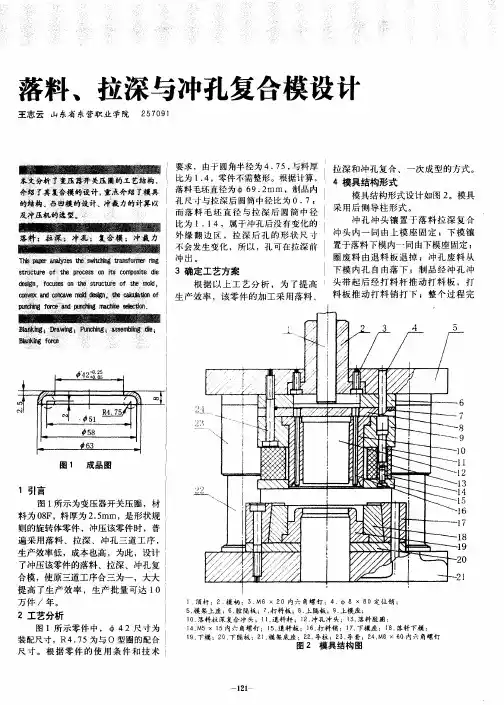
端盖的拉深、落料、冲孔复合模设计绪论模具是现代工业生产的重要工艺装备。
随着工业技术的迅速发展,在国民经济的各个领域都越来越多地依赖模具来进行加工。
采用模具来进行生产,具有以下的特点:能绝大部分的代替传统的切削加工工艺,可以提高生产效率,保证零件的质量,节约原材料,降低成本;而且模具生产出来的产品能“一模一样”,达到最大的互换性,极大程度的满足现代工业中互换性的标准及要求。
模具,特别是精密、复杂、长寿命的模具,是衡量一个国家模具发展水平的重要标志。
工业发达国家在汽车、电子、仪表、轻工业等方面的发展,产品的先进性、竞争力,在很大程度上取决于模具的先进性。
在我国,随着生产和科学技术的发展,特别是20世纪80年代以来,产品的更新换代速度加快,品种数量迅速增加。
这使得模具的需求量不断增加,质量也要求越来越高,从而使模具技术在国民经济中的地位和作用日趋重要。
近年来,日本的汽车、手表、家用电器等产品的产量猛增,品种繁多,并在国际市场占据优势地位,其重要原因之一就是模具技术的高度发展。
可见,研究和发展模具技术,对促进国民经济的发展具有特别重要的意义。
目前,我国冲压技术与工业发达国家相比还相当落后,主要原因是我国在冲压基础理论及成形工艺,模具标准化、模具设计、模具制造工艺及设备等方面与工业发达国家尚有相当大的差距,导致我国模具在寿命,效率、加工精度、生产周期等方面与发达国家的模具相比差距相当大。
例如,精密加工设备在模具加工设备中的比重比较低;CAD/CAE/CAM技术的普及率不高;许多先进的模具技术应用不够广泛等等,致使相当一部分大型,精密、复杂和长寿命的模具依赖进口。
随着科学技术的不断进步和工业生产的迅速发展,冲压加工作为现代工业领域内重要的生产手段之一,更加体现出其特有的优越性。
在现代工业生产中,由于市场竞争日益激烈,产品性能和质量要求越来越高,更新换代的速度越来越快,冲压产品正朝着复杂化,多样化高、性能、高质量方向发展,模具也正朝着复杂化,高效率、高精度、长寿命方向发展。
湖南湘潭纺织职工大学湘潭技师学院毕业设计课题:落料拉深冲孔复合模零件加工工艺设计数控07A4班专业班级孙喆学生姓名张立夏指导教师目录绪论任务书 (3)第一章、分析理解及备CAD图 (4)第二章、本次设计的基本内容 (10)一、冲裁机械运动 (10)二、拉深模具的机械运动 (11)三、模具的工作原理 (11)第三章、主要零件加工工艺分析 (14)一、落料凹模 (14)二、落料拉深凸凹模 (17)三、冲孔凸模 (21)四、拉深冲孔凸凹模 (23)五、凸模固定板 (28)设计总结 (31)参考文献 (32)绪论加入世贸组织后,我国机械制造业迎来了空前的发展机遇,我国正逐步变成世界制造中心。
为了增强竞争能力,中国制造业开始广泛使用先进的数控技术、模具技术、二十一世纪机械制造业的竞争,其实是数控技术的竞争。
随着数控技术,模具技术的迅速发展及数控机床的急剧增长,我国机械企业急需大批数控机床编程、操作等技术人才,体现现代技术高速发展的情况。
随着科学技术的飞速发展,社会对产品多样化的要求日益强烈,产品更新越来越快,多品种、批量生产的比重明显增加;同时,激烈的市场竞争要求产品研制生产周期越来越短,形状复杂的零件越多,精度要求也越高。
传统的加工设备和制造方法难于适应这种多样化、柔性化与复杂形状的高效高质量加工要求。
本内容反映了理论密切结束实际,分析重于计算,贯穿了质量、生产率和经济性的辩证关系,在能力培养上应力图由浅入深,由表及里。
强调科学分析实验验证和择优决策的能力培养。
必须重视生产实习和现场教学等实践性环节。
密切联系生产实践,在实践中发现问题,提出关键之所在并找到有效解决问题解决问题的措施,从而加深课程内容的理解,在实践中强化对所学知识的应用。
数控技术应用专业毕业设计任务书设计题目:拉深冲孔复合模主要零件的设计与制造工艺姓名:孙喆班级:07A4指导老师:张立夏一、要求:理解拉深冲孔复合模的结构特点与工作过程。
二、根据落料拉深冲孔复合模的总装图(见附件)设计其主要零件的零件图,包括:冲孔凸模、拉深冲孔凸凹模、落料拉深凸凹模以及落料凹模。
毕业设计(论文)说明书课题名称罩圈落料、拉深、冲孔、翻边复合模设计系别机械工程及自动化专业机械工程及自动化班级机自Z104班学号 **************姓名指导教师李启袭2014 年 5 月 10 日摘要模具是家电、汽车、电子、机械等工业的基本工艺,作为最基础的工业,对整个工业的发展是非常重要的,随着经济的发展,模具工业已经成为国民经济建设的重要产业。
模具分为冷冲压模具、热锻造模具、塑料模具、铸造模具等各种模具。
冷冲压模具是个历史悠久的技术成熟的的工业。
在模具行业里面占据大部分的比重。
这套模具设计是冷冲压模具,我设计的这套模具为垫块。
用到模具生产中落料,弯曲,翻边等工艺。
用到两套模具,一套是落料,另一套但是弯曲跟翻边。
主要的方法是:先对工件进行可行性分析,从工件的特性得出加工工序,再确定工艺方案,然后进行工艺参数计算,得出相应的参数,根据参数选择合理的冲压设备,再进行模具的总体方案设计。
途中再发现问题就继续修改已有的错误。
通过反反复复的修改才完成这次设计。
完成这次设计,所需的知识贯穿整个大学期间的学习,巩固了原有的知识体系,也掌握了新的知识,更加培养了查找知识的能力,通过多种渠道的知识整理跟资源整合,进一步提高了我的各种能力。
AbstractMold is home appliance, automotive, electronics, machinery industry, the basic process as the most basic industry, is very important to the development of the industry, with the development of economy, mouldindustry has become an important industry in national economic construction. Mould is divided into cold stamping dies, hot forging mould, plastic mould, casting mould and die. Cold stamping die is a mature technology with a long history of the industry. In the mold industry accounts for most of the inside.The mould design is cold stamping die, I design the mould for the block. Used mold production lagged, bending, flanging process etc. Using two sets of mould, is a set of blanking, but another set of bending and flanging.The main method is: first the feasibility analysis was carried out on the workpiece, from the characteristics of the workpiece machining process, then determine the processing plan, and the process parameters calculated, it is concluded that the corresponding parameters, according to the parameter selection and reasonable stamping equipment, and overall scheme design of the mould. On the way to found that the problem will continue to modify the existing errors. Through repeated modifications to finish the design.Required to complete the design of knowledge throughout the university during the period of study, consolidate the original system of knowledge, master new knowledge, also more to cultivate the ability to search for knowledge, knowledge through various channels and resources integration, to further improve my capabilities.目录摘要 (1)绪论 (4)1零件的工艺分析 (4)1.1 工件特点 (4)1.2 08﹟钢板性能分析 (5)1.3 工件的尺寸精度 (6)2 工艺方案的分析和确定 (7)2.1 工艺方案的分析及确定 (7)2.2 排样图的确定 (7)3 各工序冲裁压力的计算及冲压设备的选择 (11)3.1 各工序冲裁压力的计算 (11)3.2 冲压设备的选择 (13)3.3 压力中心的确定 (14)4 模具结构的设计 (16)4.1 模具的总体结构 (16)4.2 各块模板的作用及材料的选取 (16)5 成形零部件的设计 (19)5.1 凸、凹模的设计 (19)5.1.1 凸、凹模的作用 (19)5.2 冲裁间隙 (19)5.3 刃口尺寸的计算原则 (20)5.4 工作零件刃口尺寸计算 (21)5.4.1 落料部分的刃口尺寸计算 (21)5.5 主要零部件的结构设计 (24)6 标准零件的选取 (29)6.1 模架的选取 (29)6.2 模架导柱导套的选取 (29)6.3 最终模具结构总体装配图...................... 错误!未定义书签。
端盖落料拉深冲孔复合模摘要随着中国工业不断地发展,模具行业也显得越来越重要。
本文针对端盖的冲裁工艺性和拉深工艺性,分析比较了成形过程的三种不同冲压工艺(单工序、复合工序和连续工序),确定用一幅复合模完成落料、拉深和冲孔的工序过程。
介绍了端盖冷冲压成形过程,经过对端盖的批量生产、零件质量、零件结构以及使用要求的分析、研究,按照不降低使用性能为前提,将其确定为冲压件,用冲压方法完成零件的加工,且简要分析了坯料形状、尺寸,排样、裁板方案,拉深次数,冲压工序性质、数目和顺序的确定。
进行了工艺力、压力中心、模具工作部分尺寸及公差的计算,并设计出模具。
还具体分析了模具的主要零部件(如凸凹模、卸料装置、拉深凸模、垫板、凸模固定板等)的设计与制造,冲压设备的选用,凸凹模间隙调整和编制一个重要零件的加工工艺过程。
列出了模具所需零件的详细清单,并给出了合理的装配图。
通过充分利用现代模具制造技术对传统机械零件进行结构改进、优化设计、优化工艺方法能大幅度提高生产效率,这种方法对类似产品具有一定的借鉴作用。
关键词:端盖;模具设计;复合模;拉深冲孔7ABSTRACTWith China's industries continue to develop and die industry is also becoming increasingly important. Based on the Cover of the stamping process and the deep drawing process, Comparative analysis of the process of forming three different stamping process (single processes, complex processes and continuous processes) confirm completion of a composite model blanking, drawing processes and punching process. On the cover of the cold stamping process, right after the Cover of the mass production, quality components, and the use of structural components of the analysis, research, in line with lower performance prerequisite to the identification of stampings, Stamping method used to complete the processing components, and a brief analysis of the blank shape, size, layout, the Conference Board, the number of Drawing, stamping processes in nature, number and sequence determination. For the process, the center of pressure, the die size and the tolerance of the calculation, design mold. Also analyzes the mold of the main components (such as punch and die and dump devices, drawing punch, slates, Punch plate, etc.) design and manufacturing, stamping equipmentselection, punch-gap adjustment and establishment of a vital parts machining process. Die requirements set out a detailed list of parts, and gives a reasonable assembly. By fully utilizing modern manufacturing technology to mold traditional mechanical parts for structural improvements, design optimization, Process optimization methods can greatly enhance production efficiency, the method of similar products have some reference.Keywords: Cover; Mold design; Composite molding; Drawing Punch8主要符号表目录1 分析零件的工艺性 .................................................................................. 1 2 确定工艺方案 (2)2.1 计算毛坯尺寸 (2)2.2 确定是否要压边圈 (3)2.3 计算拉深次数 (3)2.4 确定工艺方案 ·····································································································4 3 主要工艺参数的计算 (5)3.1 确定排样、裁板方案 (5)3.2 计算工艺力、初选设备 (6)3.2.1 计算工艺力 (6)(1)落料力 (6)(2)冲孔力 (7)(3)推件力 (7)(4)拉深力 (7)(5)压边力 (8)3.2.2 拉深功的计算 (9)3.2.3 初选压力机 (9)3.2.4 计算压力中心 (10)3.2.5 计算凸、凹模刃口尺寸及公差 ·································································· 10 4 模具的结构设计 (12)4.1 模具结构形式的选择 (12)4.1.1 模架的选用 (12)4.1.2 模具的闭合高度 (13)4.2 模具工作部分尺寸计算 (13)4.2.1 落料凹模 (1)34.2.2 拉深凸模 (1)44.2.3 凸凹模 (15)4.2.4 弹压御料板 (16)4.2.5 上垫板 ········································································································ 18 IX主要符号表4.2.6 压边圈 ········································································································ 19 5 模具的整体安装 (20)5.1 模具的总装配 (2)5.2 模具零件 ··········································································································· 21 6 选定冲压设备 ........................................................................................ 22 7 模具的装配 .. (22)7.1 复合模的装配 (2)27.2 凸、凹模间隙的调整 ······················································································· 22 8 重要零件的加工工艺过程编制 ···························································· 23 结论 ············································································································· 26 参考文献 ·····································································································27 致谢 ············································································································· 28 附录 ············································································································· 30 实习报告 (37)X1 分析零件的工艺性冲压件工艺性是指冲压零件在冲压加工过程中加工的难易程度。
轴承盖落料、拉深、冲孔复合模摘要介绍了轴承盖冷冲压成形过程,经过对轴承盖的批量生产、零件质量、零件结构以及使用要求的分析、研究,按照不降低使用性能为前提,将其确定为冲压件,用冲压方法完成零件的加工,冲压基本工序为:落料、拉深、冲孔,然后根据对工序的初步计算,确定工序数目,如冲压次数,拉深次数,对工序顺序的安排,一般根据各工序的变形特点,质量要求来确定,由于本工件为带孔的落料、拉深件,因此先落料,再拉深,最后冲孔,根据生产批量和条件(冲压加工条件和模具制造条件)确定工序组合,因为生产批量大,所以将各个工序组合在一起,并用复合模冲压,这样就提高了产品的生产率。
通过充分利用现代模具制造技术对传统机械零件进行结构改进、优化设计、优化工艺方法能大幅度提高生产效率,这种方法对类似产品具有一定的借鉴作用。
关键字:轴承盖;冲压;工序;生产批量;生产效率ABSTRACTIntroduced to carry the bearing cover cold hurtle to press to take shape the process, pass by to the batch quantity production, spare parts quantity, the spare parts structure and usage request of carry the bearing cover of analysis, study, according to not lower to use the function as premise, is certain in order to hurtle to press the piece, it uses to hurtle to press the method to complete the spare parts to process, hurtling to press basic work preface is: Fall to anticipate, pull deep, hurtle the bore, then according to the initial calculation of the work preface, make sure the work ordinal number eyes, if hurtle to press the number of times, pulling the deep number of times, to the in proper order arrangement of the work preface, general transform the characteristics according to each work preface, the quantity request to certain, because of in order to take the bore to fall to anticipate, pull the deep piece, this work piece so fall to anticipate first, then pull deeply, blunt bore of end, according to produce the batch quantity and condition( hurtle to press to process the condition and molding tools to make the condition)s to make sure the work that the preface combine, because of produce the batch quantity big, so combine each work preface together, counteract compound the mold hurtles to press, raising the rate of production of the product thus. Pass to make use of the modern molding tool manufacturing technique to carry on the structure improvement to the traditional machine spare parts well, excellent turn the design, the excellent chemical engineering skill method ability the significant exaltation produces the efficiency, this kind of method to similar the product has to certainly draw lessons from the function.Key words: bearing cover; stamping; process; Production batch; Production efficiency目录1 分析零件的工艺性 (2)1.1 冲裁工艺性 (2)1.2 拉深工艺性 (2)2 分析计算确定工艺方案 (4)2.1 计算毛坯尺寸 (4)2.2 确定是否需要压边圈 (4)2.3 计算拉深次数 (5)2.4 确定工艺方案 (6)3 主要工艺参数的计算 (7)3.1 确定排样、裁板方案 (7)3.2 计算工艺力、初选压力机 (8)3.2.1 计算工艺力 (8)3.2.2 初选压力机 (11)3.3 计算压力中心 (11)3.4 计算凸、凹模刃口尺寸及公差 (12)4 模具的整体结构设计 (14)4.1 模具结构形式的选择 (14)4.2 模具总体设计 (14)4.3 模具工作部分尺寸计算 (15)4.3.1 落料凹模 (15)4.3.2 冲孔凸模 (16)4.3.3 拉深凸模 (16)4.3.4 凸凹模 (16)5 模具的主要零部件结构设计 (18)5.1 模架 (18)5.2 模座 (18)5.3 模柄 (18)5.4 定位零件 (19)5.4.1 挡料销 (19)5.4.2 导料销 (19)5.4.3 导料板 (19)5.5 卸料装置 (20)5.5.1 固定卸料板 (20)5.5.2 橡胶 (21)5.6 其他支撑与固定零件 (21)5.6.1 凸模固定板 (21)5.6.2 导向零件 (22)5.6.3 垫板 (22)5.7 紧固件 (22)6 确定冲压设备 (24)7 模具的装配 (25)7.1 复合模的装配 (25)7.2 凸、凹模间隙的调整 (25)8 重要零件的加工工艺过程编制 (26)结论 (28)致谢 (29)参考文献 (30)1 分析零件的工艺性1.1 冲裁工艺性冲裁件的工艺性是指冲裁件对冲压工艺的适应性,即冲裁件的结构形状、尺寸大小、精度等级是否符合冲裁加工的工艺要求。
良好的结构工艺性应保证材料消耗少,工序数目少,模具结构简单而寿命高,产品质量稳定,操作简单单等等。
通常对冲裁件的工艺性影响最大的是几何形状尺寸和精度要求。
对几何形状的要求是冲裁件的形状应尽可能简单、对称,最好采用圆形、矩形等规则的几何形状或由这些形状所组成,使排样时废料最少;冲裁件的凸出悬臂和凹槽的宽度不宜太小,以免凸模折断;冲裁件的外形或内形的转角出,要避免夹角出现,应以圆弧过渡,以便于模具加工,减少热处理或冲压时的在尖角处开裂的现象,同时可以防止尖角部位的刃口磨损过快而使模具寿命降低。
对精度的要求是冲裁件的经济精度一般不高于IT11级,最高可达IT8~10级,冲孔比落料的精度约高一级。
该零件的形状如图1,其冲裁工艺性为:(1)结构与尺寸:该零件结构较简单、形状对称,完全由圆弧和直线组成,没有长的悬臂和狭槽。
(2)精度:零件尺寸除中心孔和两中心孔的距离尺寸接近IT11级外,其余尺寸均为自由尺寸且无其他特殊要求,利用普通冲裁方法可以达到零件图样要求。
(3)材料:该零件材料为20号钢,屈服强度为450Mpa,此材料具有良好的结构强度和塑性,其冲裁加工性较好。
(4)生产批量:大批量生产。
根据以上分析,该零件的冲裁性较好,可以冲裁加工。
1.2 拉深工艺性影响拉深件工艺性的因素主要有拉深件的结构与尺寸、精度和材料。
拉深工艺性对结构与尺寸的要求是拉深件因尽量简单、对称,并能一次拉深成形;拉深件的壁厚公差或变薄量一般不应超出拉深工艺壁厚变化规律;当零件一次拉深的变形程度过大时,为避免拉裂,需采用多次拉深,这时在保证必要的表面质量前提下,应允许内、外表面存在拉深过程中可能产生的痕迹;在保证装配要求下,应允许拉深件侧壁有一定的斜度;拉深件的径向尺寸应只标注外形尺寸或内形尺寸,而不能同时标注内、外形尺寸。
工艺性对精度的要求是一般情况下,拉深件的尺寸精度应在IT13级以下,不宜高于IT11级;对于精度要求高的拉深件,应在拉深后增加整形工序,以提高其精度,由于材料各向异性的影响,拉深件的口部或凸缘外缘一般是不整齐的,出现“突耳”现象,需要增加切边工序。
工艺性要求材料具有良好的塑性,屈强比b s σσ/小,板厚方向性系数r 大,板平面方向性系数r ∆小。
屈强比b s σσ/值越小,一次拉深允许的极限变形程度越大,拉深的性能越好;板厚方向性系数r 和板平面方向性系数r ∆反映了材料的各向异性性能,当r 较大或r ∆较小时,材料宽度的变形比厚度方向的变形容易,板平面方向性能差异较小,拉深过程中材料不易变薄或拉裂,因而有利于拉深成形。
该零件可看成带凸缘的圆筒形件,料厚t=2mm ,拉深后厚度不变;零件底部圆角半径r=3mm 凸缘处的圆角半径也为R=3mm ;尺寸公差都为自由公差,满足拉深工艺对精度等级的要求;零件所用材料20号钢塑性好,易于拉深成形。
根据以上分析,该零件的拉深工艺性较好,可用拉深工序加工。
所以,该零件的加工工艺性较好。
图1 工件图2 分析计算确定工艺方案2.1 计算毛坯尺寸由于板料在扎压或退火时所产生的聚合组织而使材料引起残存的方向性,反映到拉深过程中,就使桶形拉深件的口部形成明显的突耳。
此外,如果板料本身的金属结构组织不均匀、模具间隙不均匀、润滑的不均匀等等,也都会引起冲件口高低不齐的现象,因此就必需在拉深厚的零件口部和外缘进行修边处理。
这样在计算毛坯尺寸的时候就必需加上修边余量然后再进行毛坯的展开尺寸计算。